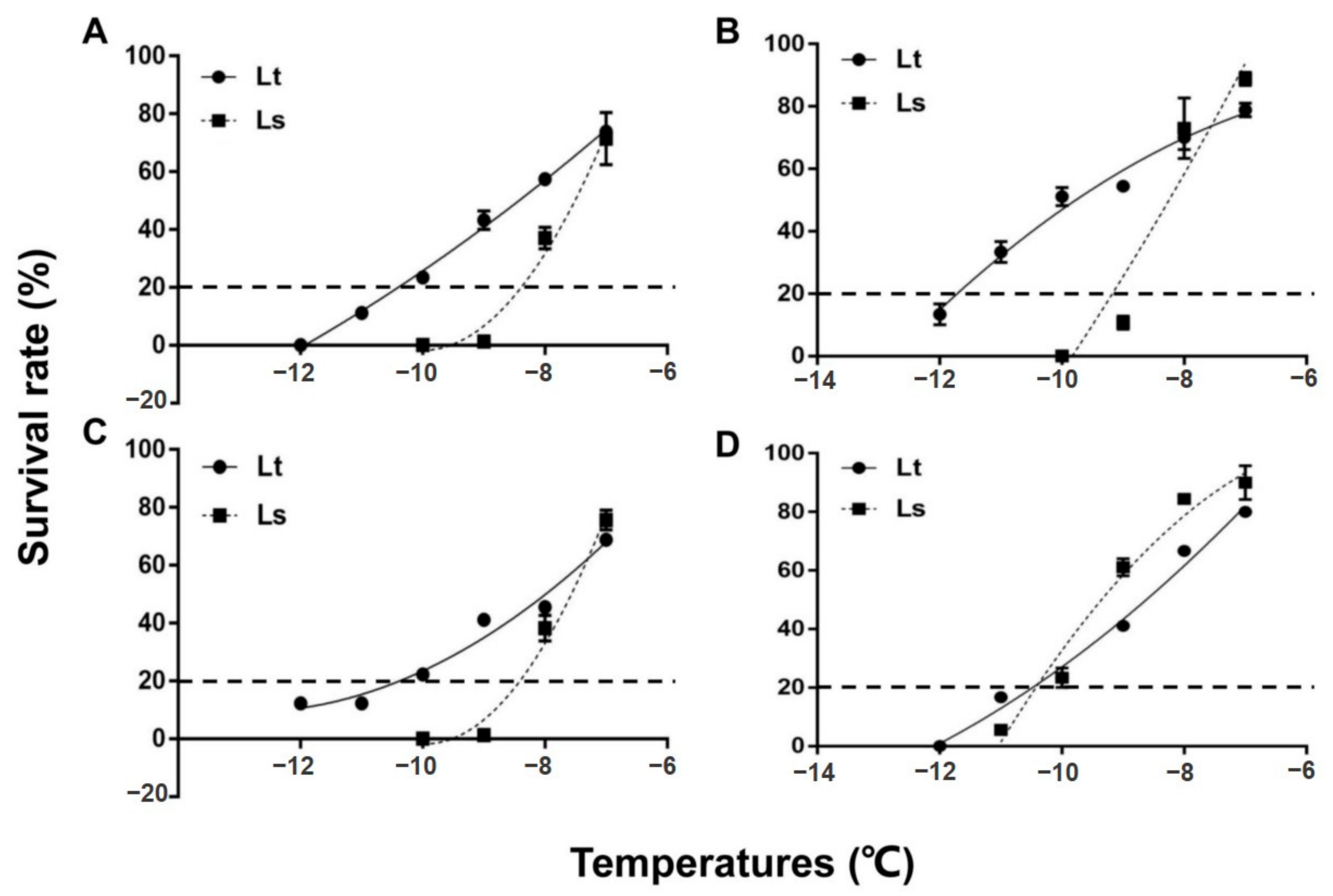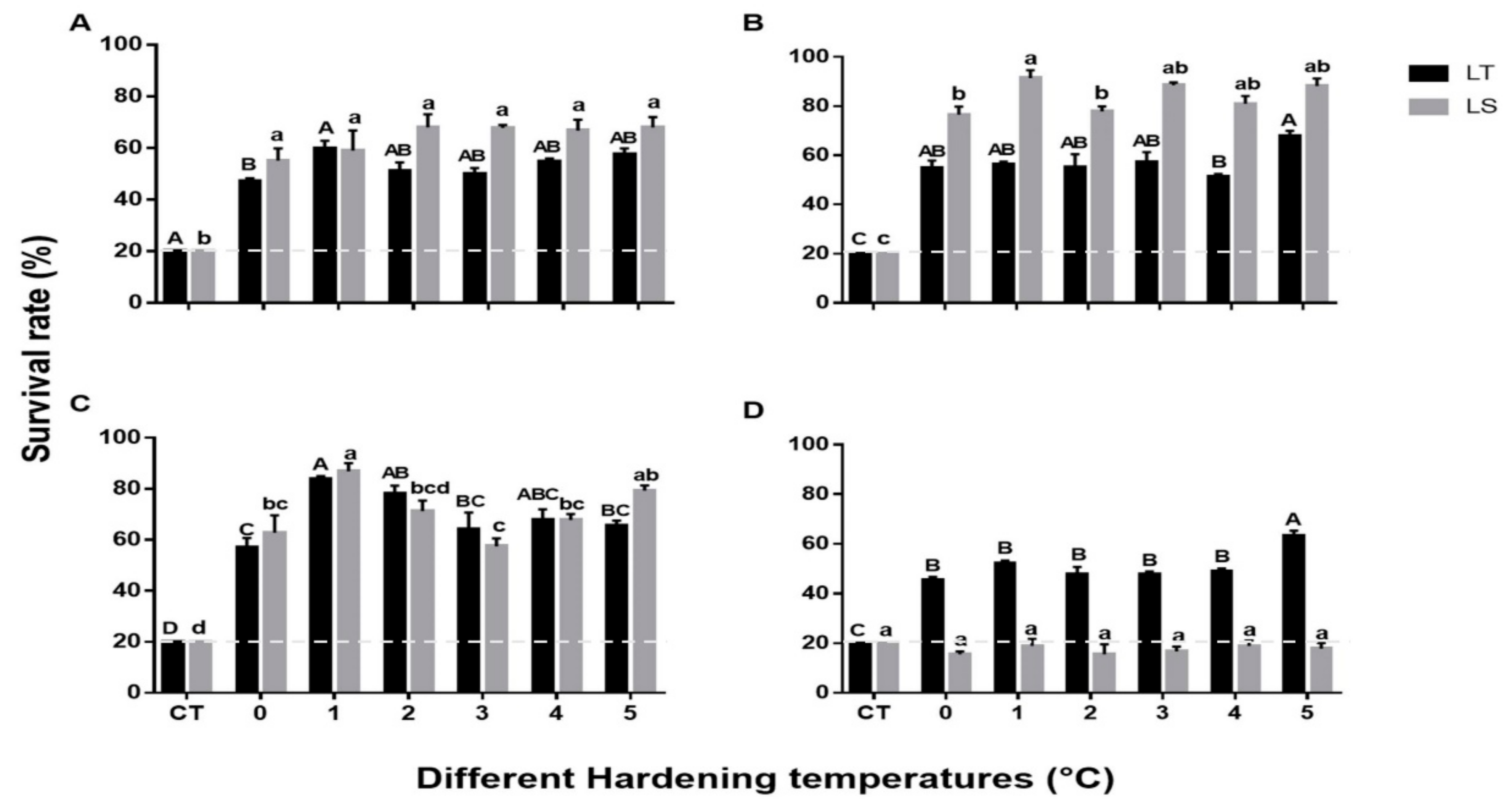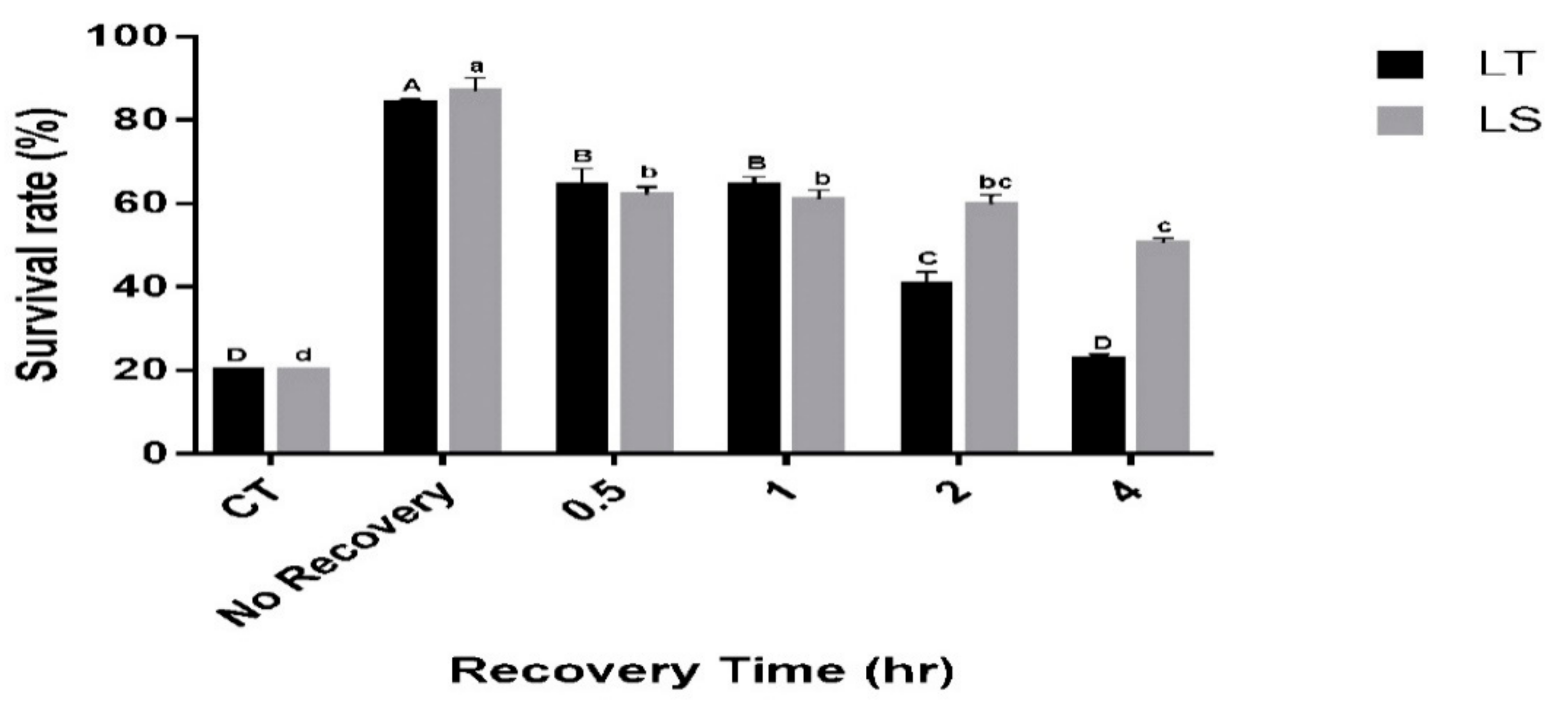Differential Response of Leafminer Flies Liriomyza trifolii (Burgess) and Liriomyza sativae (Blanchard) to Rapid Cold Hardening
Abstract
:Simple Summary
Abstract
1. Introduction
2. Materials and Methods
2.1. Insect Rearing
2.2. Critical Temperature
2.3. Assessment of the Rapid Cold Hardening (RCH) Response
2.4. Determination of Supercooling Point (SCP)
2.5. Statistical Analysis
3. Results
3.1. Critical Temperature
3.2. Assessment of RCH and Its Response to Different Hardening Temperatures
3.3. Durabilility of RCH
3.4. Determination of Supercooling Points
4. Discussion
5. Conclusions
Author Contributions
Funding
Institutional Review Board Statement
Informed Consent Statement
Data Availability Statement
Acknowledgments
Conflicts of Interest
References
- Spencer, K.A. Agromyzidae (Diptera) of Economic Importance. 9: Series Entomologica; The Hague Publishers: Bath, UK, 1973; pp. 19–28. [Google Scholar]
- Iwasaki, A. A newly recorded pest, Liriomyza sativae Blanchard in Japan. Plant Prot. 2000, 54, 12–17. [Google Scholar]
- Iwasaki, A.; Iwaizumi, R.; Takano, S. A newly recorded pest, Liriomyza huidobrensis (Blanchard) in Japan. Shokubutsu Boeki 2004, 58, 13–19. [Google Scholar]
- Scheffer, S.J.; Lewis, M.L. Mitochondrial phylogeography of the vegetable pest Liriomyza trifolii (Diptera: Agromyzidae): Diverged clades and invasive populations. Ann. Entomol. Soc. Am. 2006, 99, 991–998. [Google Scholar] [CrossRef]
- Kang, L.; Chen, B.; Wei, J.N.; Liu, T.X. Roles of thermal adaptation and chemical ecology in Liriomyza distribution and control. Annu. Rev. Entomol. 2009, 54, 127–145. [Google Scholar] [CrossRef]
- Xiang, J.; Lei, Z.; Wang, H.; Gao, Y. Interspecific competition among three invasive Liriomyza species. Shengtai Xuebao/Acta Ecol. Sin. 2012, 32, 1616–1622. [Google Scholar]
- Wan, F.H.; Yang, N.W. Invasion and management of agricultural alien insects in China. Annu. Rev. Entomol. 2016, 61, 77–98. [Google Scholar] [CrossRef] [PubMed]
- Lei, Z.; Wen, J.; Wang, Y. Research Progress of the Vegetable Leafminer in China and Suggestion in the Future Control; Annals of Agricultural Science of China Youth Beijing, China Agricultural Press: Beijing, China, 1997; pp. 495–499. [Google Scholar]
- Gao, Y.; Reitz, S.R.; Wei, Q.; Yu, W.; Zhang, Z.; Lei, Z. Local crop planting systems enhance insecticide-mediated displacement of two invasive leafminer fly. PLoS ONE 2014, 9, e92625. [Google Scholar] [CrossRef]
- Gao, Y.; Reitz, S.; Xing, Z.; Ferguson, S.; Lei, Z. A decade of leafminer invasion in China: Lessons learned. Pest Manag. Sci. 2017, 73, 1775–1779. [Google Scholar] [CrossRef]
- Wang, Z.; Guan, W.; Chen, D.H. Preliminary report of the Liriomyza trifolii in Zhongshan area. Plant Q. 2007, 21, 19–20. [Google Scholar]
- Liu, C.; Lu, Y.; Zeng, L.; Liu, H.; Zhang, W. Host plants of American serpentine leaf miner, Liriomyza trifolii, in Guangdong in Spring. Chin. Bull. Entomol. 2007, 44, 574–576. [Google Scholar]
- Liu, H.; Liu, C.Y.; Li, N.D.; Zeng, L. Damage of leafminer Liriomyza trifolii in vegetable fields in Zhongshan city. Guangdong Agric. Sci. 2012, 48, 92–96. [Google Scholar]
- Zhang, Q.; Wu, S.; Wang, H.; Xing, Z.; Lei, Z. Overwintering, cold tolerance and supercooling capacity comparison between Liriomyza sativae and L. trifolii, two invasive leafminers in China. J. Pest Sci 2021, 1–8. [Google Scholar] [CrossRef]
- Chen, B.; Kang, L. Implication of pupal cold tolerance for the northern over-wintering range limit of the leafminer Liriomyza sativae (Diptera: Agromyzidae) in China. App. Entomol. Zool. 2005, 40, 437–446. [Google Scholar] [CrossRef] [Green Version]
- Bale, J.S.; Masters, G.J.; Hodkinson, I.D.; Awmack, C.; Bezemer, T.M.; Brown, V.K.; Butterfield, J.; Buse, A.; Coulson, J.C.; Farrar, J. Herbivory in global climate change research: Direct effects of rising temperature on insect herbivores. Glob. Chang. Biol. 2002, 8, 1–16. [Google Scholar] [CrossRef]
- Hoffmann, A.A.; Sørensen, J.G.; Loeschcke, V. Adaptation of Drosophila to temperature extremes: Bringing together quantitative and molecular approaches. J. Therm. Biol. 2003, 28, 175–216. [Google Scholar] [CrossRef]
- Wang, H.; Reitz, S.R.; Xiang, J.; Smagghe, G.; Lei, Z. Does temperature-mediated reproductive success drive the direction of species displacement in two invasive species of leafminer fly? PLoS ONE 2014, 9, e98761. [Google Scholar]
- Chang, Y.W.; Chen, J.Y.; Lu, M.X.; Gao, Y.; Tian, Z.H.; Gong, W.R.; Dong, C.S.; Du, Y.Z. Cloning and expression of genes encoding heat shock proteins in Liriomyza trifolii and comparison with two congener leafminer species. PLoS ONE 2017, 12, e0181355. [Google Scholar]
- Chang, Y.W.; Zhang, X.X.; Lu, M.X.; Gong, W.R.; Du, Y.Z. Transcriptome analysis of Liriomyza trifolii (Diptera: Agromyzidae) in response to temperature stress. Comp. Biochem. Physiol. D Genom. Proteom. 2020, 34, 100677. [Google Scholar] [CrossRef]
- Overgaard, J.; MacMillan, H.A. The integrative physiology of insect chill tolerance. Annu. Rev. Physiol. 2017, 79, 187–208. [Google Scholar] [CrossRef]
- Sinclair, B.J.; Alvarado, L.E.C.; Ferguson, L.V. An invitation to measure insect cold tolerance: Methods, approaches, and workflow. J. Therm. Biol. 2015, 53, 180–197. [Google Scholar] [CrossRef] [Green Version]
- Andreadis, S.S.; Athanassiou, C.G. A review of insect cold hardiness and its potential in stored product insect control. Crop Prot. 2017, 91, 93–99. [Google Scholar] [CrossRef]
- Abe, Y.; Tokumaru, S. Displacement in two invasive species of leafminer fly in different localities. Biol. Invas. 2008, 10, 951–995. [Google Scholar] [CrossRef]
- Abe, Y. Invasion of Japan by exotic leafminers Liriomyza spp. (Diptera: Agromyzidae) and its consequences. App. Entomol. Zool. 2017, 52, 175–182. [Google Scholar] [CrossRef]
- Lee, R.E., Jr. Rapid cold-hardening: Ecological significance and underpinning mechanisms. Low Temp. Biol. Insects 2010, 35–58. [Google Scholar] [CrossRef]
- Teets, N.M.; Gantz, J.; Kawarasaki, Y. Rapid cold hardening: Ecological relevance, physiological mechanisms and new perspectives. J. Exp. Biol. 2020, 223, jeb203448. [Google Scholar] [CrossRef]
- Coulson, S.; Bale, J.S. Characterisation and limitations of the rapid cold-hardening response in the housefly Musca domestica (Diptera: Muscidae). J. Insect Physiol. 1990, 36, 207–211. [Google Scholar] [CrossRef]
- Powell, S.; Bale, J.S. Cold shock injury and ecological costs of rapid cold hardening in the grain aphid Sitobion avenae (Hemiptera: Aphididae). J. Insect Physiol. 2004, 50, 277–284. [Google Scholar] [CrossRef] [PubMed]
- Lee, R.E.; Chen, C.P.; Denlinger, D.L. A rapid cold-hardening process in insects. Science 1987, 238, 1415–1417. [Google Scholar] [CrossRef] [Green Version]
- MacMillan, H.A.; Guglielmo, C.G.; Sinclair, B.J. Membrane remodeling and glucose in Drosophila melanogaster: A test of rapid cold-hardening and chilling tolerance hypotheses. J. Insect Physiol. 2009, 55, 243–249. [Google Scholar] [CrossRef]
- Park, Y.; Kim, Y. A specific glycerol kinase induces rapid cold hardening of the diamondback moth, Plutella xylostella. J. Insect Physiol. 2014, 67, 56–63. [Google Scholar] [CrossRef]
- Colinet, H.; Hoffmann, A.A. Comparing phenotypic effects and molecular correlates of developmental, gradual and rapid cold acclimation responses in Drosophila melanogaster. Func. Ecol. 2012, 26, 84–93. [Google Scholar] [CrossRef]
- Chen, B.; Kang, L. Cold hardiness and supercooling capacity in the pea leafminer Liriomyza huidobrensis. Cryo Lett. 2002, 23, 173–182. [Google Scholar]
- McDonald, J.; Bale, J.; Walters, K.J. Rapid cold hardening in the western flower thrips Frankliniella occidentalis. J. Insect Physiol. 1997, 43, 759–766. [Google Scholar] [CrossRef]
- Denlinger, D.; Yocum, G.; Rinehart, J.; Gilbert, L. Hormonal control of diapause. Comp. Insect Mol. Sci. 2004, 3, 615–650. [Google Scholar]
- Koštál, V. Eco-physiological phases of insect diapause. J. Insect Physiol. 2006, 52, 113–127. [Google Scholar] [CrossRef]
- Czajka, M.C.; Lee, R.E. A rapid cold-hardening response protecting against cold shock injury in Drosophila melanogaster. J. Exp. Biol. 1990, 148, 245–254. [Google Scholar] [CrossRef] [PubMed]
- Nyamukondiwa, C.; Terblanche, J.S.; Marshall, K.; Sinclair, B.J. Basal cold but not heat tolerance constrains plasticity among Drosophila species (Diptera: Drosophilidae). J. Evol. Biol. 2011, 24, 1927–1938. [Google Scholar] [CrossRef]
- Gerken, A.R.; Eller, O.C.; Hahn, D.A.; Morgan, T.J. Constraints, independence, and evolution of thermal plasticity: Probing genetic architecture of long-and short-term thermal acclimation. Proc. Natl. Acad. Sci. USA 2015, 112, 4399–4404. [Google Scholar] [CrossRef] [Green Version]
- Gerken, A.R.; Eller-Smith, O.C.; Morgan, T.J. Speed of exposure to rapid cold hardening and genotype drive the level of acclimation response in Drosophila melanogaster. J. Therm. Biol. 2018, 76, 21–28. [Google Scholar] [CrossRef]
- Everman, E.R.; Ledbetter, N.; Morgan, T.J. The persistence of short-term cold acclimation in Drosophila melanogaster (Diptera: D rosophilidae). Physiol. Entomol. 2017, 42, 291–298. [Google Scholar] [CrossRef]
- Chang, Y.W.; Shen, Y.; Dong, C.; Gong, W.R.; Tian, Z.H. Population dynamics of Liriomyza trifolii and Liriomyza sativae in Jiangsu. Chin. J. Appl. Entomol. 2016, 53, 884–891. [Google Scholar]
- Broufas, G.D.; Koveos, D.S. Rapid cold hardening in the predatory mite Euseius (Amblyseius) finlandicus (Acari: Phytoseiidae). J. Insect Physiol. 2001, 47, 699–708. [Google Scholar] [CrossRef]
- Cha, W.H.; Lee, D.W. Identification of rapid cold hardening-related genes in the tobacco budworm, Helicoverpa assulta. J. Asia Pac. Entomol. 2016, 19, 1061–1066. [Google Scholar] [CrossRef]
- Dillon, M.E.; Woods, H.A.; Wang, G.; Fey, S.B.; Vasseur, D.A.; Telemeco, R.S.; Marshall, K.; Pincebourde, S. Life in the frequency domain: The biological impacts of changes in climate variability at multiple time scales. Integr. Comp. Biol. 2016, 56, 14–30. [Google Scholar] [CrossRef] [PubMed]
- Sgro, C.M.; Terblanche, J.S.; Hoffmann, A.A. What can plasticity contribute to insect responses to climate change? Annu. Rev. Entomol. 2016, 61, 433–451. [Google Scholar] [CrossRef] [Green Version]
- Kelty, J.D.; Lee, R.E., Jr. Induction of rapid cold hardening by cooling at ecologically relevant rates in Drosophila melanogaster. J. Insect Physiol. 1999, 45, 719–726. [Google Scholar] [CrossRef]
- Kelty, J. Rapid cold-hardening of Drosophila melanogaster in a field setting. Physiol. Entomol. 2007, 32, 343–350. [Google Scholar] [CrossRef]
- Overgaard, J.; Sørensen, J.G. Rapid thermal adaptation during field temperature variations in Drosophila melanogaster. Cryobiology 2008, 56, 159–162. [Google Scholar] [CrossRef]
- Koveos, D.S. Rapid cold hardening in the olive fruit fly Bactrocera oleae under laboratory and field conditions. Entomol. Exp. Appl. 2001, 101, 257–263. [Google Scholar] [CrossRef]
- Chen, C.P.; Lee, R.E.; Denlinger, D.L. A comparison of the responses of tropical and temperate flies (Diptera: Sarcophagidae) to cold and heat stress. J. Comp. Physiol. 1990, 160, 543–547. [Google Scholar] [CrossRef]
- Terblanche, J.S.; Clusella-Trullas, S.; Deere, J.A.; Chown, S.L. Thermal tolerance in a south-east African population of the tsetse fly Glossina pallidipes (Diptera, Glossinidae): Implications for forecasting climate change impacts. J. Insect Physiol. 2008, 54, 114–127. [Google Scholar] [CrossRef]
- Kelty, J.D.; Lee, R.E., Jr. Rapid cold-hardening of Drosophila melanogaster (Diptera: Drosophiladae) during ecologically based thermoperiodic cycles. J. Exp. Biol. 2001, 204, 1659–1666. [Google Scholar] [CrossRef]
- Chen, C.P.; Lee, R.E., Jr.; Denlinger, D.L. Cold shock and heat shock: A comparison of the protection generated by brief pre-treatment at less severe temperatures. Physiol. Entomol. 1991, 16, 19–26. [Google Scholar] [CrossRef]
- Kawarasaki, Y.; Teets, N.M.; Denlinger, D.L.; Lee, R.E., Jr. The protective effect of rapid cold-hardening develops more quickly in frozen versus supercooled larvae of the Antarctic midge, Belgica antarctica. J. Exp. Biol. 2013, 216, 3937–3945. [Google Scholar] [CrossRef] [PubMed] [Green Version]
- Qiang, C.K.; Du, Y.Z.; Yu, L.Y.; Cui, Y.D.; Zheng, F.S.; Lu, M.X. Effect of rapid cold hardening on the cold tolerance of the larvae of the rice stem borer, Chilo suppressalis (Walker). Agric. Sci. China 2008, 7, 321–328. [Google Scholar] [CrossRef]
- Ju, R.T.; Xiao, Y.Y.; Li, B. Rapid cold hardening increases cold and chilling tolerances more than acclimation in the adults of the sycamore lace bug, Corythucha ciliata (Say) (Hemiptera: Tingidae). J. Insect Physiol. 2011, 57, 1577–1582. [Google Scholar] [CrossRef]
- Shintani, Y.; Ishikawa, Y. Relationship between rapid cold-hardening and cold acclimation in the eggs of the yellow-spotted longicorn beetle, Psacothea hilaris. J. Insect Physiol. 2007, 53, 1055–1062. [Google Scholar] [CrossRef]
- Zhao, Y.Y.; Kang, L. Cold tolerance of the leafminer Liriomyza sativae (Dipt., Agromyzidae). J. Appl. Entomol. 2000, 124, 185–189. [Google Scholar] [CrossRef]
- Bale, J.S. Insect cold hardiness: A matter of life and death. Eur. J. Entomol. 1996, 93, 369–382. [Google Scholar]
- Chevin, L.-M.; Lande, R.; Mace, G.M. Adaptation, plasticity, and extinction in a changing environment: Towards a predictive theory. PLoS Biol. 2010, 8, e1000357. [Google Scholar] [CrossRef] [Green Version]
- Zheng, X.; Cheng, W.; Wang, X.; Lei, C. Enhancement of supercooling capacity and survival by cold acclimation, rapid cold and heat hardening in Spodoptera exigua. Cryobiology 2011, 63, 164–169. [Google Scholar] [CrossRef]
- Andreadis, S.S.; Spanoudis, C.G.; Athanassiou, C.G.; Savopoulou-Soultani, M. Factors influencing supercooling capacity of the koinobiont endoparasitoid Venturia canescens (Hymenoptera: Ichneumonidae). Pest Manag. Sci. 2014, 70, 814–818. [Google Scholar] [CrossRef] [PubMed]
- Coleman, P.C.; Bale, J.S.; Hayward, S.A. Cross-generation plasticity in cold hardiness is associated with diapause, but not the non-diapause developmental pathway, in the blow fly Calliphora vicina. J. Exp. Biol. 2014, 217, 1454–1461. [Google Scholar] [PubMed] [Green Version]
- Tantowijoyo, W.; Hoffmann, A.A. Identifying factors determining the altitudinal distribution of the invasive pest leafminers Liriomyza huidobrensis and Liriomyza sativae. Entomol. Exp. Appl. 2010, 135, 141–153. [Google Scholar] [CrossRef]
- China Meteorological Data Service Center. Available online: http://data.cma.cn/en (accessed on 16 August 2021).
- Ye, H. Distribution of the oriental fruit fly (Diptera: Tephritidae) in Yunnan province. Entomol. Sin. 2001, 8, 175–182. [Google Scholar]
- Ren, L.; Lu, Y.Y.; Zeng, L. Cold hardiness of pupae and over-wintering adults from natural populations of Bactrocera dorsalis (Hendel) (Diptera: Tephritidae) in China. Acta Entomol. Sin. 2007, 50, 588–596. [Google Scholar]
- Wang, J.; Zeng, L.; Han, Z. An assessment of cold hardiness and biochemical adaptations for cold tolerance among different geographic populations of the Bactrocera dorsalis (Diptera: Tephritidae) in China. J. Insect Sci. 2014, 14, 1–6. [Google Scholar] [CrossRef] [Green Version]
- Gibert, P.; Hill, M.; Pascual, M.; Plantamp, C.; Terblanche, J.S.; Yassin, A.; Sgrò, C.M. Drosophila as models to understand the adaptive process during invasion. Biol. Invasions 2016, 18, 1089–1103. [Google Scholar] [CrossRef]
- Vázquez, D.P.; Gianoli, E.; Morris, W.F.; Bozinovic, F. Ecological and evolutionary impacts of changing climatic variability. Biol. Rev. 2017, 92, 22–42. [Google Scholar] [CrossRef] [Green Version]
- Walsh, B.S.; Parratt, S.R.; Hoffmann, A.A.; Atkinson, D.; Snook, R.R.; Bretman, A.; Price, T.A.R. The impact of climate change on fertility. Trends Ecol. Evol. 2019, 34, 249–259. [Google Scholar] [CrossRef]




| Age of Pupae (Days) | L. sativae (°C) | L. trifolii (°C) |
|---|---|---|
| 2 | −8.67 ± 0.61 | −19.1 ± 0.14 |
| 5 | −10.65 ± 0.84 | −19.5 ± 0.1 |
| 7 | −9.30 ± 0.61 | −19.2 ± 0.25 |
| Statistical analysis | F2,87 = 2.085 p = 0.130 | F2,87 = 2.046 p = 0.135 |
Publisher’s Note: MDPI stays neutral with regard to jurisdictional claims in published maps and institutional affiliations. |
© 2021 by the authors. Licensee MDPI, Basel, Switzerland. This article is an open access article distributed under the terms and conditions of the Creative Commons Attribution (CC BY) license (https://creativecommons.org/licenses/by/4.0/).
Share and Cite
Iqbal, J.; Zhang, X.-X.; Chang, Y.-W.; Du, Y.-Z. Differential Response of Leafminer Flies Liriomyza trifolii (Burgess) and Liriomyza sativae (Blanchard) to Rapid Cold Hardening. Insects 2021, 12, 1041. https://doi.org/10.3390/insects12111041
Iqbal J, Zhang X-X, Chang Y-W, Du Y-Z. Differential Response of Leafminer Flies Liriomyza trifolii (Burgess) and Liriomyza sativae (Blanchard) to Rapid Cold Hardening. Insects. 2021; 12(11):1041. https://doi.org/10.3390/insects12111041
Chicago/Turabian StyleIqbal, Junaid, Xiao-Xiang Zhang, Ya-Wen Chang, and Yu-Zhou Du. 2021. "Differential Response of Leafminer Flies Liriomyza trifolii (Burgess) and Liriomyza sativae (Blanchard) to Rapid Cold Hardening" Insects 12, no. 11: 1041. https://doi.org/10.3390/insects12111041
APA StyleIqbal, J., Zhang, X.-X., Chang, Y.-W., & Du, Y.-Z. (2021). Differential Response of Leafminer Flies Liriomyza trifolii (Burgess) and Liriomyza sativae (Blanchard) to Rapid Cold Hardening. Insects, 12(11), 1041. https://doi.org/10.3390/insects12111041






